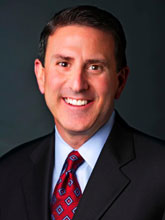Sam’s Club CEO Brian Cornell once attended a conference at Apple that was designed to give corporate executives a chance to learn some of the secrets behind the late Steve Jobs’s success. Cornell recalled asking Jobs how much he relied on focus groups to find out what his customers might be looking for, particularly when it came to developing the iPhone.
“He told me [the iPhone] wasn’t even particularly on the company’s agenda, that they were really looking at other categories of products,” Cornell said during a recent Wharton Leadership lecture. “But he and his executives were sitting around each day and complaining about how they hated their phones. They realized that it was probably also true of their customers. It’s not that Apple invented the mobile phone, but Jobs could see that by taking away a customer’s pain point — making a better phone — he could make a customer for life. For that he has been celebrated, as well he should, since one of the great things you have to do as a company — as a leader — is be aware of your customer’s pain points and alleviate them.”
Cornell came to Sam’s Club, the $50 billion warehouse shopping division of Wal-Mart, in April 2009 after a 20-year career in consumer products marketing, primarily at PepsiCo. There, among other positions, he was the president of North American food services, regional president for the company’s European and African beverage division and president of Tropicana International.
He was wary of leaving consumer products for retail, but ultimately realized that, in many ways, the principles of leadership would be the same at Sam’s Club as at PepsiCo. “The center of your strategy has to be, in each business, understanding your consumer,” Cornell noted. “Everyone in our organization has to wake up every day and think about what the consumer wants. We have to make good choices. We have to select good products for our customers.”
Cornell, however, is careful to call his customers “members,” since the 47 million Sam’s Club shoppers pay $40-$100 a year, depending on the level of discounts or services they receive, to shop at the company’s more than 600 stores in the United States. (There are about 100 additional locations in China, Mexico and Brazil.) “I like to use the term ‘member’ because we have a contract with the people who shop at Sam’s Club, which means we have to be even more conscious, category by category, of what our members want,” he said. Warehouse shopping, he noted, is different from typical supermarkets, which may have as many as 40,000 items in their inventories. Sam’s Club, and its major competitors, Costco and BJ’s Wholesale Club, carry only about 6,000-7,000 products, and usually only one brand — sometimes a house brand — of each item.
But Sam’s Club is moving toward carrying more private label items, which Cornell said has become the trend in Europe. While American wholesale clubs rarely have more than 25% of their stock in private labels, in England, the proportion would be more like 50%. In Scandinavia, private labels account for as much as 70% of the inventory offered by wholesale chains, Cornell added.
“Customers say they are looking for great value and lower priced alternatives, but private label quality has to [become] better,” Cornell said. “There are always consumers among our members who love their favorite brands, so we have to be conscious of that, too.”
Finding that balance has become more important as American consumers grow increasingly price conscious. “We have for several years now been dealing with a U.S. consumer under tremendous stress,” Cornell noted. “The uncertainty in the environment means we are seeing consumers [who are] basically in survival mode. Consumers are trying to survive day to day, and the first thing they do is pull back on discretionary spending. They have seen friends, neighbors and family [members] lose jobs and maybe lose their houses. It has changed their behavior and I don’t expect that value equation to change any time soon. The lesson for the last five years is that value is here to stay.”
In the warehouse category, Sam’s Club’s $50 billion in sales is second to Costco’s $88 billion. Both chains have about 600 domestic stores. BJ’s, which is primarily located in the Northeast, is a distant third with about $11 billion in annual revenue and about 200 stores. While Cornell does not expect Sam’s Club to knock Costco out of first place in the near future, he predicts that all three chains will do well in the coming years, with at least 5% annual increases in sales, due to the value and cost savings consumers now desire.
‘C’ Is For …
Like many other executives, Cornell likes to sum up his leadership essentials using a mnemonic device. His principles all start with the letter “C”. The first and most important “C”, he said, is to concentrate on the customer. “Whether you are an investment banker, in the consumer packaged goods world, in health care, retail, whatever, you have to be a student of the consumer. You have to know what they are doing with their time, what they are reading, where they shop and how they spend their money. It is absolutely critical. With business so rapidly changing, you have to know, up to the minute, what is happening in the consumer environment.”
To that end, he and other Sam’s Club executives visit stores and talk directly with customers. “Customers aren’t coming to my office. I have to go to them,” he said. The need to be customer-centric has also driven Cornell to invest more in technology. Customers today often come shopping with their smartphones in tow, Cornell noted, and Sam’s Club was the first warehouse chain to offer Wi-Fi in all of its stores. Using the Wi-Fi network, Sam’s Club members are able to quickly ask friends and relatives through Facebook or other social networks whether this or that item is worth buying.
Another of Cornell’s “C’s” is competition and keeping a wary eye on competitors. “I really believe that in business today, you have to know as much about your competition as your own business. When I worked for Tropicana and Pepsi, I knew as much about Coke as I did about our products. We studied their every move,” said Cornell. He makes sure everyone in his employ knows what Costco is doing. “We never travel in a market without going into their buildings. We have to understand their brands, the quality they offer and where they are ahead of us — and then how to take what they do well one step beyond.”
Cornell’s least favorite “C,” but the one he suggested is most important, is cost. “This is hardly fun talk, but all of us have to focus on managing costs,” he noted. “You have to manage budgets. You have to find how to be productive. Cost management provides the fuel for tomorrow’s innovation growth. You have to take the budgets you tighten and refunnel that money into tomorrow’s growth.”
His final “C” stands for the importance of having strong colleagues. “When you are young and in college, you learn to do things on your own,” he said. “But you get out into the business world and it is all about how you work with other people. If you can’t do that, you can’t be a good leader. No matter how smart you think you are, you can’t do anything alone.”
Building a Healthier Leader
Sam’s Club is entering its next phase in good shape, Cornell noted: The chain has had successive gains in same store sales in every quarter during his three years there. But Cornell said he constantly has to stay cognizant of where the store can improve. One of his most challenging moments came at the beginning of 2010, when he decided that Sam’s Club did not have a competency in doing in-store sampling of food and other products.
“We could have spent the time to do training, I suppose, but it wasn’t a core competency,” he noted. That meant laying off 10,000 employees and convincing the entire team that the move was the best thing for the company. “We had to tell our associates that [it] wasn’t an easy decision.” Though most of the employees laid off were part-timers, they accounted for about 10% of the company’s staff.
But Cornell stressed the importance of leaders taking responsibility for unpopular decisions and being ready to immediately respond to tough situations. “When you are a leader, you can’t take a day off,” he stated. “What if I said an executive does a great job Mondays through Thursdays, but Fridays? Eh, not her day. Would you want her to be running anything?”
Being a strong leader does not mean burning the candle at both ends 24 hours a day, however, Cornell added. He recalled attending an off-site training program a decade ago, when he was still employed at Pepsi. There were the usual seminars about sales, marketing and cost containment — and one titled “energy management,” which Cornell initially assumed was about how to manage costs in technology and the like.
The session turned out to be about the importance of good nutrition, exercise and rest, which Cornell now believes are vital for effective executives. He noted that leaders at some companies revel in describing how they stayed up until 3 a.m. and skipped a couple of meals to be ready for an important 8 a.m. presentation.
But Cornell has adopted a different approach. “If I am at the hospital and a doctor tells me he was up until 3 a.m. answering his email, is that the doctor I want operating on my Mom in the morning?” he asked. “It is the same way in business. It is important to always be in shape, to manage energy in that regard.” Cornell encourages employees at Sam’s Club to exercise every day, to eat right and to come to work well rested. “I want to work hard and be well-prepared,” he noted. “But I also want my employees to be at their peak as often as possible, and that means having the proper rest.”
That said, there is no one attribute Cornell looks for in an employee. “I want people to mesh, but that means everyone can have a different strength,” he said. “They have to be strategic thinkers, but also be able to run day-to-day operations. The best is to be able to adapt and mesh strengths. It is my job to have a team that works, and that means different kinds of people, especially in a business world that is changing so quickly and in ways we can’t yet know.”



